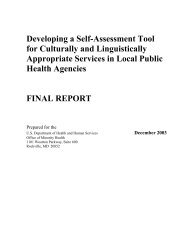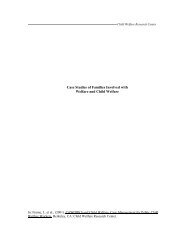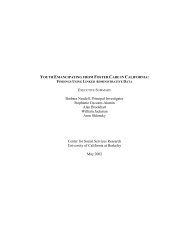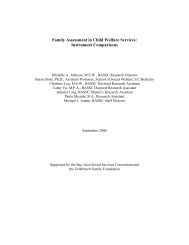Predictors of Resilience in Maltreated and Nonmaltreated Latino ...
Predictors of Resilience in Maltreated and Nonmaltreated Latino ...
Predictors of Resilience in Maltreated and Nonmaltreated Latino ...
Create successful ePaper yourself
Turn your PDF publications into a flip-book with our unique Google optimized e-Paper software.
Table 6<br />
Influences <strong>of</strong> Maltreatment, Gender, the Overall Counselor Relationship Variable, <strong>and</strong> the<br />
Interpersonal Relationship Variables on Level <strong>of</strong> Resilient Function<strong>in</strong>g<br />
Step F df R 2<br />
In the second hierarchical regression analysis, the <strong>in</strong>fluences <strong>of</strong><br />
the <strong>in</strong>dividual features <strong>of</strong> the relationship with the head counselor<br />
were exam<strong>in</strong>ed. Maltreatment status <strong>and</strong> gender were entered at<br />
Steps 1 <strong>and</strong> 2 <strong>of</strong> the regression equation, followed by the <strong>in</strong>terpersonal<br />
variables, which were simultaneously entered <strong>in</strong> the third<br />
step <strong>of</strong> the analysis (see Table 6). Maltreatment status <strong>and</strong> the<br />
<strong>in</strong>terpersonal variables <strong>of</strong> “conflicted,” “warm,” <strong>and</strong> “closed/troubled”<br />
uniquely contributed to the variance <strong>in</strong> the total resilient<br />
function<strong>in</strong>g score. Together, maltreatment status, gender, <strong>and</strong> the<br />
<strong>in</strong>terpersonal variables resulted <strong>in</strong> a highly significant regression<br />
equation, F(7, 97) 22.5, p .01, account<strong>in</strong>g for 61.9% <strong>of</strong> the<br />
variance <strong>in</strong> resilient function<strong>in</strong>g (adjusted R 2 .59). The <strong>in</strong>terpersonal<br />
variables uniquely accounted for 53.5% <strong>of</strong> the variance <strong>in</strong><br />
the resilient function<strong>in</strong>g score, R 2 .54, F(5, 97) 27.25, p <br />
.01, which is similar to the amount <strong>of</strong> variance accounted for by<br />
the overall quality <strong>of</strong> the relationship with the head counselor.<br />
Next, separate regression analyses were conducted to explore<br />
whether any <strong>of</strong> the <strong>in</strong>terpersonal relationship variables related to<br />
the composite <strong>of</strong> resilient function<strong>in</strong>g differentially for maltreated<br />
<strong>and</strong> nonmaltreated Lat<strong>in</strong>o children. To do so, we evaluated possible<br />
<strong>in</strong>teraction effects between maltreatment status <strong>and</strong> the <strong>in</strong>terpersonal<br />
variables. In each <strong>of</strong> these analyses, maltreatment status<br />
was entered first, followed by one <strong>of</strong> the <strong>in</strong>terpersonal variables,<br />
<strong>and</strong> f<strong>in</strong>ally by the <strong>in</strong>teraction between maltreatment <strong>and</strong> the <strong>in</strong>terpersonal<br />
variable. No significant <strong>in</strong>teractions were found for the<br />
“warm,” “dependent,” <strong>and</strong> “conflicted” <strong>in</strong>terpersonal variables. In<br />
contrast, the <strong>in</strong>teraction between maltreatment status <strong>and</strong> the<br />
“closed/troubled” variable was found to be significant, account<strong>in</strong>g<br />
for an additional 2.6% <strong>of</strong> the variance <strong>in</strong> resilient function<strong>in</strong>g<br />
scores, R 2 .03, F(1, 101) 3.76, p .05. As shown <strong>in</strong> Figure<br />
1, the negative relation between closed/troubled relationship features<br />
<strong>and</strong> resilient function<strong>in</strong>g was stronger for nonmaltreated<br />
children ( .54) than maltreated children ( .40).<br />
The <strong>in</strong>teraction <strong>of</strong> maltreatment status <strong>and</strong> open communication<br />
was also found to be significant, account<strong>in</strong>g for 3.1% <strong>of</strong> the<br />
variance <strong>in</strong> the resilient function<strong>in</strong>g scores, R 2 .03, F(1,<br />
101) 4.37, p .05. As shown <strong>in</strong> Figure 2, the positive relation<br />
Adjusted R 2<br />
Step 1 6.32* 1, 103 .06 .05<br />
Maltreatment status .24 .06*<br />
Step 2 4.64* 2, 102 .03 .07<br />
Maltreatment status .21 .04*<br />
Gender .16 .03<br />
Step 3a 48.22** 3, 101 .51 .58<br />
Maltreatment status .01 .00<br />
Gender .04 .00<br />
Overall counselor relationship .76 .51**<br />
Step 3b 22.49** 7, 97 .54 .59<br />
Maltreatment status .01 .00<br />
Gender .01 .00<br />
Conflicted .43 .07**<br />
Warm .26 .02*<br />
Open communication .12 .01<br />
Dependent .17 .01<br />
Closed/troubled .18 .02*<br />
* p .05. ** p .01.<br />
PREDICTORS OF RESILIENCE IN LATINO CHILDREN<br />
between open communication <strong>and</strong> resilient function<strong>in</strong>g was stronger<br />
for nonmaltreated ( .58) than maltreated ( .30) Lat<strong>in</strong>o<br />
children.<br />
Discussion<br />
This <strong>in</strong>vestigation was designed to ga<strong>in</strong> an underst<strong>and</strong><strong>in</strong>g <strong>of</strong> the<br />
impact <strong>of</strong> child maltreatment on Lat<strong>in</strong>o children as well as to<br />
exam<strong>in</strong>e the processes contribut<strong>in</strong>g to resilient function<strong>in</strong>g <strong>in</strong><br />
Lat<strong>in</strong>o children at high risk for adverse outcomes. Consistent with<br />
our first hypothesis, maltreated Lat<strong>in</strong>o children ev<strong>in</strong>ced more<br />
difficulty across multiple aspects <strong>of</strong> function<strong>in</strong>g than their equally<br />
socioeconomically disadvantaged nonmaltreated Lat<strong>in</strong>o peers.<br />
Even though both maltreated <strong>and</strong> nonmaltreated Lat<strong>in</strong>o children<br />
experienced multiple adversities that placed them at high risk for<br />
maladaptive function<strong>in</strong>g (i.e., liv<strong>in</strong>g <strong>in</strong> s<strong>in</strong>gle-parent homes with<br />
multiple children, low SES, dependency on the state for f<strong>in</strong>ancial<br />
support, <strong>and</strong> m<strong>in</strong>ority status), maltreated children ev<strong>in</strong>ced more<br />
difficulties <strong>in</strong> several important areas <strong>of</strong> function<strong>in</strong>g. In accord<br />
with prior <strong>in</strong>vestigations <strong>of</strong> resilience <strong>in</strong> samples <strong>of</strong> maltreated<br />
children that have been composed predom<strong>in</strong>antly <strong>of</strong> African<br />
American <strong>and</strong> European American children (Cicchetti & Rogosch,<br />
1997; Cicchetti et al., 1993), maltreated Lat<strong>in</strong>o children were rated<br />
by both peers <strong>and</strong> counselors as hav<strong>in</strong>g more difficulties <strong>in</strong> <strong>in</strong>terpersonal<br />
relations (e.g., exhibit<strong>in</strong>g greater aggressive behavior <strong>and</strong><br />
less prosocial behavior <strong>and</strong> be<strong>in</strong>g more likely to be rated as<br />
fighters) than nonmaltreated Lat<strong>in</strong>o children, <strong>and</strong> they also displayed<br />
more symptoms <strong>of</strong> <strong>in</strong>ternaliz<strong>in</strong>g <strong>and</strong> externaliz<strong>in</strong>g behavior<br />
problems than nonmaltreated Lat<strong>in</strong>o children.<br />
Furthermore, consistent with other studies <strong>of</strong> resilience <strong>and</strong><br />
maltreatment (Cicchetti & Rogosch, 1997; Cicchetti et al., 1993;<br />
McGlo<strong>in</strong> & Widom, 2001; Moran & Eckenrode, 1992), maltreated<br />
Lat<strong>in</strong>o children demonstrated a lower level <strong>of</strong> resilient function<strong>in</strong>g<br />
than did equally disadvantaged nonmaltreated Lat<strong>in</strong>o children.<br />
Moreover, several Lat<strong>in</strong>o children ev<strong>in</strong>ced a paucity <strong>of</strong> resilient<br />
striv<strong>in</strong>gs (39.5% maltreated vs. 19.3% nonmaltreated), highlight<strong>in</strong>g<br />
the fact that <strong>in</strong> addition to ethnicity, SES, <strong>and</strong> other high-risk<br />
sr 2<br />
345

















